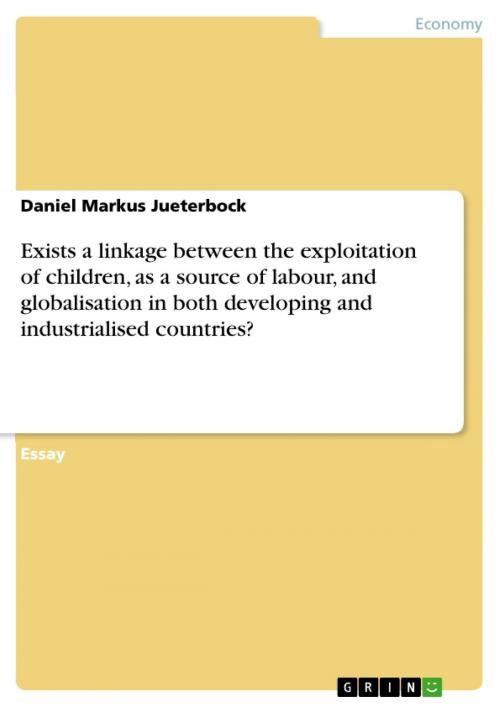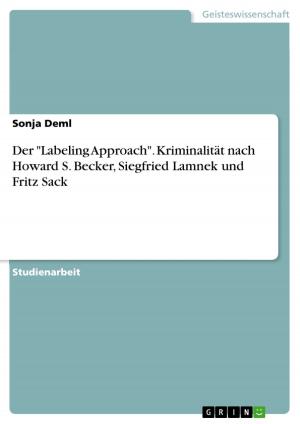Exists a linkage between the exploitation of children, as a source of labour, and globalisation in both developing and industrialised countries?
Business & Finance, Human Resources & Personnel Management| Author: | Daniel Markus Jueterbock | ISBN: | 9783656181408 |
| Publisher: | GRIN Verlag | Publication: | May 2, 2012 |
| Imprint: | GRIN Verlag | Language: | English |
| Author: | Daniel Markus Jueterbock |
| ISBN: | 9783656181408 |
| Publisher: | GRIN Verlag |
| Publication: | May 2, 2012 |
| Imprint: | GRIN Verlag |
| Language: | English |
Essay from the year 2008 in the subject Economics - Job market economics, grade: 78, Curtin University of Technology (Curtin Business School), course: Industrial Relations (Asia Pacific) 302, language: English, abstract: This report tries to evaluate the question whether there is a linkage between globalisation and child labour in developing and industrialised countries. It takes India and Germany as examples and analyses their situation due to this issue. Globalisation is a process enforced by companies. Therefore, child labour is defined by the ILO as the exploitation by companies. In this context it is not in its worst form of slavery, prostitution or as soldier in an armed conflict. This report shows that society in India accepts child labour, whereas Germans prohibit it. Historically, Germany's laws regarding child labour were initiated in the 19th century, a time of industrialisation. Laws protecting children in India were set in place approx. 100 years later. Economically, both countries differ as well. Germany is a service economy. But India is changing. The majority is occupied in the agricultural sector. But most of the GDP is generated by the service sector. Historically, child labour in Germany took place in the 19th century during the industrialisation. There, we have seen that child labour occurred together with two factors, poverty and productivity. Industrialisation reduces the traditional fields of occupation and results in poverty. People are forced to let their children work. Machines make children as unskilled workers possible. Only if machines become more complex, educated workers are necessary. The more complex they get, the more productive they will be. Only then, children are not productive if not educated. This event can be applied to India's recent situation. It changes from an agricultural to a service economy. It skips industrialisation. Technology shoots India to another level, but leaves the under-educated population in poverty. In globalisation, capital flows faster to the places best in use. Unsophisticated goods are produced where the price is lowest. Indians generate a GDP per capita of USD 2,700 per year. In Germany it is USD 34,200. On the other hand 80% of all Indians live on USD/day 2 or less. In Germany the welfare grants a minimum of USD/day 16. Capital flows to India as its labour is cheap. The people need the jobs to survive. The process of globalisation cannot be directly blamed to result in child labour. But it enforces poverty. Child labour is a symptom of sincere poverty. Finally, we can say that there is a link between globalisation and child labour.
Essay from the year 2008 in the subject Economics - Job market economics, grade: 78, Curtin University of Technology (Curtin Business School), course: Industrial Relations (Asia Pacific) 302, language: English, abstract: This report tries to evaluate the question whether there is a linkage between globalisation and child labour in developing and industrialised countries. It takes India and Germany as examples and analyses their situation due to this issue. Globalisation is a process enforced by companies. Therefore, child labour is defined by the ILO as the exploitation by companies. In this context it is not in its worst form of slavery, prostitution or as soldier in an armed conflict. This report shows that society in India accepts child labour, whereas Germans prohibit it. Historically, Germany's laws regarding child labour were initiated in the 19th century, a time of industrialisation. Laws protecting children in India were set in place approx. 100 years later. Economically, both countries differ as well. Germany is a service economy. But India is changing. The majority is occupied in the agricultural sector. But most of the GDP is generated by the service sector. Historically, child labour in Germany took place in the 19th century during the industrialisation. There, we have seen that child labour occurred together with two factors, poverty and productivity. Industrialisation reduces the traditional fields of occupation and results in poverty. People are forced to let their children work. Machines make children as unskilled workers possible. Only if machines become more complex, educated workers are necessary. The more complex they get, the more productive they will be. Only then, children are not productive if not educated. This event can be applied to India's recent situation. It changes from an agricultural to a service economy. It skips industrialisation. Technology shoots India to another level, but leaves the under-educated population in poverty. In globalisation, capital flows faster to the places best in use. Unsophisticated goods are produced where the price is lowest. Indians generate a GDP per capita of USD 2,700 per year. In Germany it is USD 34,200. On the other hand 80% of all Indians live on USD/day 2 or less. In Germany the welfare grants a minimum of USD/day 16. Capital flows to India as its labour is cheap. The people need the jobs to survive. The process of globalisation cannot be directly blamed to result in child labour. But it enforces poverty. Child labour is a symptom of sincere poverty. Finally, we can say that there is a link between globalisation and child labour.















